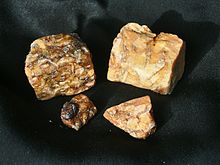Benzoin (resin)


Benzoin /ˈbɛnzoʊ.ɪn/ or benjamin (corrupted pronunciation)[1] is a balsamic resin obtained from the bark of several species of trees in the genus Styrax. It is used in perfumes and some kinds of incense and as a flavoring and medicine (see tincture of benzoin). It is distinct from the chemical compound benzoin, which is ultimately derived chemically from benzoin resin; the primary active ingredient of benzoin resin is actually benzoic acid, not benzoin.
Benzoin is sometimes called gum benzoin or gum benjamin, The syllable "benz" ultimately derives from the Arabic lubān jāwī (لبان جاوي, "frankincense from Java").
Benzoin is also called storax, not to be confused with the balsam of the same name obtained from the Hamamelidaceae family.
Benzoin is a common ingredient in
There are two common kinds of benzoin, benzoin Siam and benzoin Sumatra. Benzoin Siam is obtained from Styrax tonkinensis, found across Thailand, Laos, Cambodia, and Vietnam. Benzoin Sumatra is obtained from Styrax paralleloneurus (syn. Styrax sumatranus) and Styrax benzoin, which grows predominantly on the island of Sumatra.[6][7] Unlike Siamese benzoin, Sumatran benzoin contains cinnamic acid in addition to benzoic acid.[8] In the United States, Sumatra benzoin is more customarily used in pharmaceutical preparations, Siam benzoin in the flavor and fragrance industries.[9]
In perfumery, benzoin is used as a
In anesthesia and surgery, it is used as an adhesive to secure wound and catheter dressing and is available as a sterile preparation. [11]
See also
- Friar's Balsam– Pungent solution of benzoin resin in ethanol
References
- ^ Wedgwood, Hensleigh (1855). "On False Etymologies". Transactions of the Philological Society (6): 67. Archived from the original on 2020-06-26. Retrieved 2018-09-22.
- ISBN 9780787314125. Archivedfrom the original on 2022-07-09. Retrieved 2020-09-21.
- The Encyclopaedia of Islam, vol. 5 (2nd ed.), Brill, p. 786a
- ISBN 9788180565298. Archivedfrom the original on 9 July 2022. Retrieved 21 September 2020.
- ^ St. Alban Blend
- ISSN 2460-3945.
- ^ a b Karl-Georg Fahlbusch; et al. (2007), "Flavors and Fragrances", Ullmann's Encyclopedia of Industrial Chemistry (7th ed.), Wiley, p. 87
- ^ a b Klemens Fielbach; Dieter Grimm (2007), "Resins, Natural", Ullmann's Encyclopedia of Industrial Chemistry (7th ed.), Wiley, p. 4
- ISBN 978-0-8493-8203-1. Archivedfrom the original on 2022-04-21. Retrieved 2022-04-14.
- ^ George A. Burdock (2010), "Benzoin Resin", Fenaroli's Handbook of Flavor Ingredients (6th ed.), Taylor & Francis, pp. 139–140
- ^ "Benzoin adhesive".
